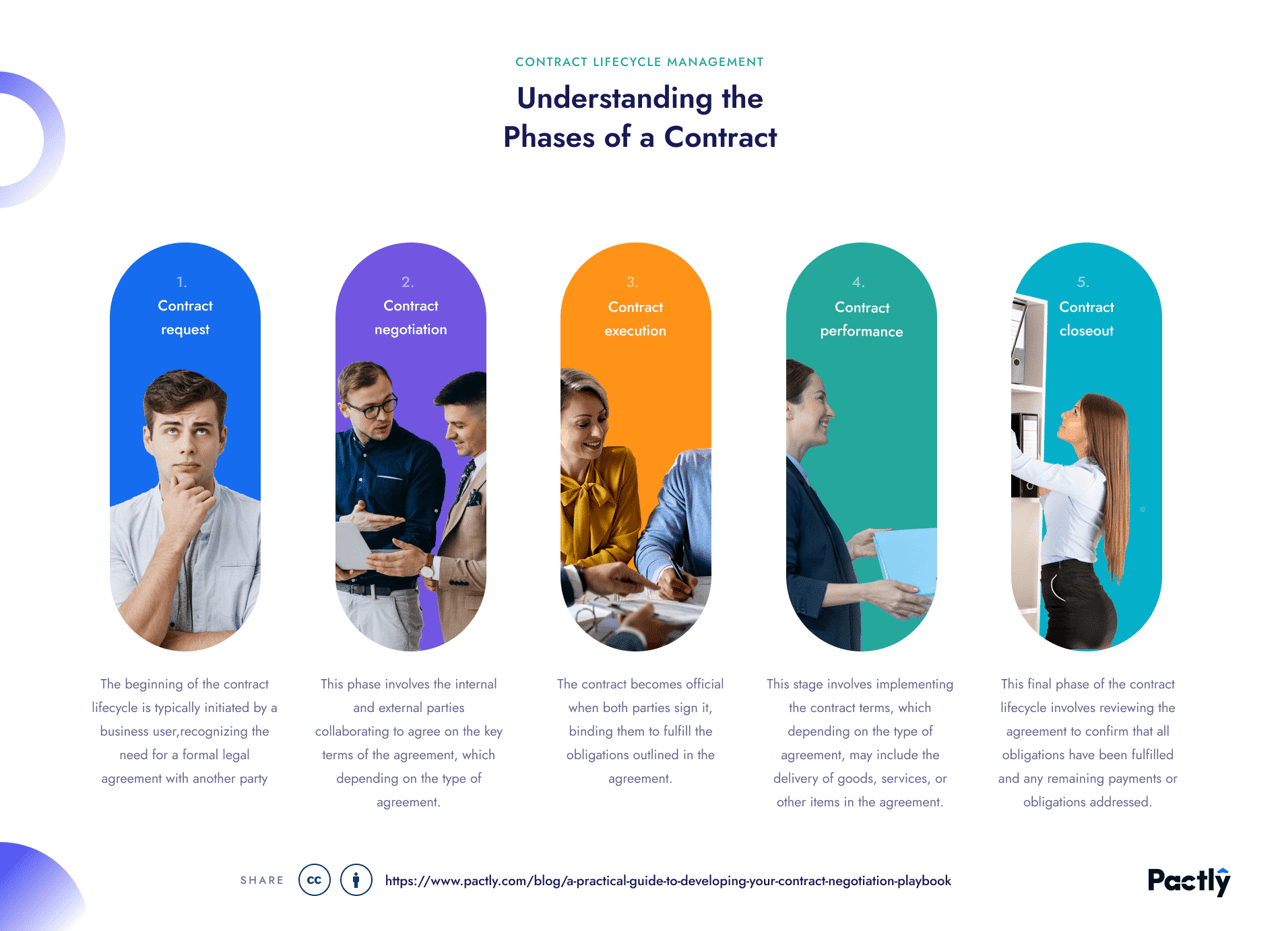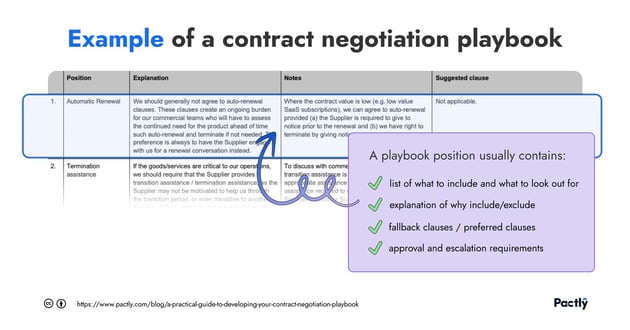Understanding the Phases of a Contract: Key Tasks and Considerations
Contract Lifecycle Management (CLM) is an integral part of modern organizations. It refers to how businesses create, review, negotiate, approval and manage contracts while reducing risk and maximizing value. The five phases of the contract lifecycle – contract request, contract negotiation, contract execution, contract performance, and contract closeout – are the building blocks of successful contract management processes. But, you might ask, what is the contract management process? In simple terms, it refers to how businesses create, review, negotiate, approve and manage contracts while reducing risk and maximizing value. It’s worth mentioning that the exact number and definition of contract lifecycle key stages can vary across organizations and software providers. However, the overarching tasks and objectives remain consistent throughout.
This article will delve into each phase, highlighting the essential tasks and considerations for a smooth and effective CLM process. Whether you’re a legal counsel creating your organization’s contracting policy or a business user looking to streamline your contract management process, this guide provides valuable insights and practical tips to help you succeed.
Overview of the Contract Lifecycle
The contract lifecycle is a series of interdependent stages that determine the success of a contractual relationship. The 5 phases of contract life cycles are: contract request, contract negotiation, contract execution, contract performance, and contract closeout.
%20-%20headings%20inside%20boxes.png?width=1900&height=1382&name=Key%20Phases%20of%20a%20Contract%20(Overview)%20-%20headings%20inside%20boxes.png)
%20-%20Mobile%20(v1).png?width=414&height=5272&name=Key%20Phases%20of%20a%20Contract%20(Overview)%20-%20Mobile%20(v1).png)
Contract request
The beginning of the contract lifecycle, also referred to as contract initiation and review, is typically initiated by a business user, such as a sales representative, HR professional, or procurement officer, recognizing the need for a formal legal agreement with another party. The business user submits a request to the legal team for assistance in drafting or reviewing the contract as part of the contract generation process, ensuring that all necessary terms and conditions are captured and defined before proceeding.
Contract negotiation
After the completion of contract generation, the contract review and negotiation phase involves the internal and external parties collaborating to agree on the key terms of the agreement, which depending on the type of agreement, may include the scope of work, timeline, payment terms, and other relevant details. This could occur by making changes to a shared document (otherwise known as redlining) or in person. In the negotiation phase, lawyers, subject matter experts, and business people might all be involved.
Contract execution
Once everything is in order, parties can arrange to sign the contract, which usually involves a comprehensive contract review process to ensure all terms and conditions are clearly outlined and agreed upon. The contract becomes official when both parties sign it, binding them to fulfill the obligations outlined in the agreement. This can happen electronically or in person and may involve an exchange of original documents or scanned copies.
Contract performance
This stage involves implementing the contract terms, which depending on the type of agreement, may include the delivery of goods, services, or other items outlined in the agreement. This can take some time and effort with both parties monitoring performance and ensuring that the terms of the agreement are being fulfilled.
Contract closeout
This final phase of the contract lifecycle involves a comprehensive review of the agreement to confirm that all obligations have been fulfilled and any remaining payments or obligations addressed, officially closing the contract. This phase often does not get as much attention as the other stages but is still important for improving your overall contract processes. By following a clear and comprehensive contract review checklist during this phase, organizations can minimize disputes and protect their interests in the future.
In the subsequent sections, you will learn about the essential tasks and best practices for each phase of the contract lifecycle, ensuring a successful contractual relationship.
Contract Request: Setting the Stage for Successful Agreements
Every contract request should start with examining the parties involved and any potential conflicts of interest or sanctions (where necessary), followed by either contract authoring or reviewing all contractual documents in detail. The legal team should be consulted to ensure that all conditions of the agreement are clearly defined and meet both parties’ expectations. Organizations may have different rules determining which contracts business users can negotiate and finalize, so it’s essential to understand these rules. Additional legal or subject matter input and review (e.g., Tax, HR, Intellectual Property Office) may be necessary for higher-value or complex contracts.
Best Practices for Contract Requests
Based on our experience and observations, the best organizations have implemented several key practices to ensure a smooth and effective contract request process. These include:
- Create a standard contract request form to ensure all relevant details are captured.
- Develop an approval workflow that enables the internal legal team to review and approve the request.
- Defining any thresholds or restrictions for contracts to be negotiated and executed or when additional legal or other subject matter expert input and review is required.
- Train business users on the policy, contracting process and even some of the contract basics, so they can better understand their obligations when signing a contract.
- Performing routine internal audits to ensure compliance with company policies and contract processes.
.png?width=1900&height=1110&name=Contract%20Request%20(v1).png)
%20-%20Mobile%20(retina%20x2).png?width=800&height=1958&name=Contract%20Request%20(v1)%20-%20Mobile%20(retina%20x2).png)
Contract Negotiation: Achieving a Win-Win Outcome
The contract negotiation phase is a critical stage that requires expertise and a deep understanding of the commercial objectives, pre-empting potential common contracting pitfalls and an appreciation of the legal and regulatory operating environment. The goal is to refine the terms of the agreement and address any potential areas of disagreement between the parties in a manner that protects the interests of all parties. Contract negotiators should thoroughly understand the commercial objectives of the contract; for example, in a services or consulting agreement, the scope of work, timeline, payment terms, and acceptance criteria would be some of the more important aspects of the contract. They should also be aware of potential issues and pitfalls arising during the contractual relationship and take steps to mitigate risk.
Best Practices for Contract Negotiation
To have successful contract negotiations, it’s important to follow established practices. Here are some of the top strategies that successful organizations use to improve their negotiation process:
- Create a contract negotiation playbook that outlines guidelines for the language and terms used, strategies for negotiation, fallback positions, hard limits, and guidance for escalation.
- Prepare thoroughly before negotiations by at least doing a quick review of the other party’s past contracts and evaluating the potential risks of the proposed agreement; using technology and contract lifecycle management software can help with this.
- Promote teamwork and inclusiveness among key players involved in the negotiations, such as the legal department, contract managers, specialist departments, and business unit; this can make a big difference in the negotiation outcomes.
- Periodically review and update your playbook to ensure it remains relevant and supports your organization’s needs.
.png?width=1900&height=1110&name=Contract%20Negotiation%20(v1).png)
%20-%20Mobile.png?width=800&height=1958&name=Contract%20Negotiation%20(v1)%20-%20Mobile.png)
Contract Execution: Formalizing the relationship
The contract execution phase marks the official start of the contractual relationship between the parties involved. This phase involves getting all the necessary contract approvals and prerequisites sorted, such as regulatory approval, licenses, or board approval. Once everything is in order, parties can arrange to sign the contract. It’s essential to determine whether electronic signatures are permitted by law and feasible for both parties or if wet signatures are required. The logistics of signing, such as the number of copies needed and the location of the signing, should also be arranged. Once the contract is signed, it’s good practice to circulate copies to all signers and any additional recipients requested by the parties. It’s crucial to store the executed contract documents securely throughout the term of the agreement, ensuring easy access when needed. By following these key tasks, organizations can ensure a smooth and successful contract execution process.
Best practices for contract execution
Getting the contract execution phase right is crucial. Poor execution can create a risk of future disputes over the agreement’s validity. The following best practices can help organizations with a smooth and effective contract execution:
- Clearly define the internal approval process, including who has the authority to sign on behalf of the organization.
- Establish a clear e-signature policy, including when electronic signatures are permitted and if they comply with local regulations.
- Ensure all parties know their obligations and responsibilities before the contract is executed.
- Store executed contracts securely for future reference and easy access.
- Continuously review and update internal policies and procedures to ensure they align with the organization’s changing needs and goals.
.png?width=1900&height=1110&name=Contract%20Execution%20(v1).png)
%20-%20Mobile.png?width=800&height=1958&name=Contract%20Execution%20(v1)%20-%20Mobile.png)
Contract Performance: Monitoring and Ensuring Compliance
The contract performance phase, also known as the contract administration phase, involves actively monitoring and managing the execution of the contract to ensure that both parties fulfill their obligations. Key tasks during this phase include tracking the delivery of goods and services, ensuring that milestones and payment timelines are met, addressing any issues or disputes that may arise, and regularly reviewing the agreement to keep it relevant and aligned with the needs of both parties. Maintaining accurate records of all communications and actions taken during the contract performance phase is crucial for efficient and effective contract administration.
Best Practices for Contract Performance
Getting the signature on the dotted line is just the start. To ensure that the contract is successfully performed and administered, contract administrators and the legal team must take a proactive approach. By implementing the following best practices, organizations can ensure that the contract performance phase runs smoothly and effectively:
- Develop a clear and detailed contract performance monitoring plan, including a schedule of deliverables, milestones, and payment timelines.
- Establish regular check-ins or progress updates with the other party to ensure the agreement is fulfilled as expected.
- Maintain accurate records of all communication, actions taken, and any changes to the agreement to ensure that everyone is on the same page.
- Implement a dispute resolution process, including escalation procedures, to address any issues arising during the contract performance phase.
- Utilize contract management software to automate contract administration tasks, such as reminders for deliverables and milestone check-ins.
- Ensure that all parties are aware of any contract renewal or notification requirements and clearly understand the contract process for renewing or extending the agreement.
.png?width=1900&height=1110&name=Contract%20Performance%20(v1).png)
%20-%20Mobile.png?width=800&height=1958&name=Contract%20Performance%20(v1)%20-%20Mobile.png)
Contract Closeout: Wrapping Up a Successful Contractual Relationship
Closing out a contract is the final step in the contractual relationship between parties. This often overlooked phase is critical in ensuring that all obligations have been fulfilled and that the contract is officially concluded. By following a clear and comprehensive checklist for contract closeout, organizations can minimize disputes and protect their interests in the future. The key steps involved in closing out a contract include the following:
- Reviewing the agreement to ensure that all outstanding obligations and responsibilities have been addressed
- Gathering relevant documents or evidence, such as proof of delivery or service completion
- Compiling final payment information and arranging for payment to be issued
- Making sure all parties are in agreement on the closeout of the contract, including signing off on any changes or modifications made during the performance phase
- Submitting a final report detailing the key elements and outcomes of the contractual relationship or update the relevant contract data in your contract lifecycle management (CLM) system
- Updating internal records to reflect that the contract has been successfully closed out.
.png?width=1900&height=1110&name=Contract%20Closeout%20(v1).png)
%20-%20Mobile.png?width=800&height=1958&name=Contract%20Closeout%20(v1)%20-%20Mobile.png)
The Importance of Contract Management Software in the Contract Lifecycle
Contract Lifecycle Management (CLM) software is an increasingly popular tool to help manage the various stages of a contract. This software provides a centralized platform for all contract-related activities, including contract creation, negotiation, execution, performance, and closeout. CLM software can assist organizations in streamlining the contract lifecycle management process and ensuring that all contract-related tasks are completed efficiently and effectively.
More than just being a contract generation software that automates the manual contract generation process, Contract Lifecycle Management Software can aid in automating many of the manual tasks involved throughout the contracting process, such as contract creation through the use of contract templates, review, and approval. It also provides a central repository for all the organization's contracts and related documents, making it easier for the relevant stakeholders to track all their contracts in one place.
Additionally, Contract lifecycle management software can help with contract negotiation by providing a secure platform for parties to collaborate on and negotiate the terms of a contract. For some platforms, like Pactly, it can allow you to create digital playbooks that help speed up the process of reviewing and redlining agreements. It can also assist with contract execution by providing an electronic signature solution, helping to reduce the time and effort required for manual signatures.
Taking the Next Step: Enhancing Your Contract Lifecycle Management Process
Contract life cycle management is a multi-step process that requires careful planning and execution to ensure a successful outcome. By following best practices and being mindful of key considerations during each phase of the contract lifecycle, organizations can increase their chances of entering into successful contracts. This article provides an overview of the various phases and highlights key tasks and considerations for each. We hope this article has provided a valuable resource for those responsible for managing contracts.
For more information on how you can improve your contract management process, consider subscribing to our newsletter for tips and tricks on contract management best practices. Or, if you’re interested in exploring how Pactly can help streamline and improve your contract lifecycle process, feel free to book a demo with one of our experts. Join us as we explore the challenges and solutions to ensuring contract compliance in the following article of our series.


